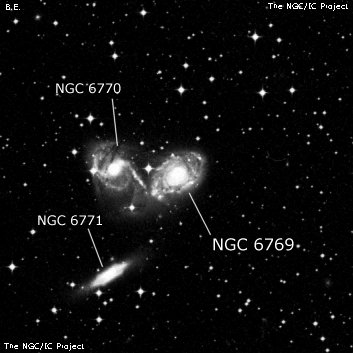NGC/IC Project Restoration Effort
(This is a very very beta version)
NGC6769


Basic Information
Location and Magnitude
Right Ascension: 19:18:22.8
Declination: -60:30:3
Constellation: PAV
Visual Magnitude: 11.8
Historic Information
Discoverer: Herschel J.
Year of discovery: 1836
Discovery aperture: 18.3
Observational
Summary description: vF, S, R, lbM, 1st of 3
Sub-type: SBb/P
Corwin's Notes
=====
NGC 6769, NGC 6770, and NGC 6771. As Delisle Stewart first reported in his
section of the big HA 60 paper on nebulae, the NGC RAs of this famous triplet
are 1 minute of time too large. These are among JH's CGH nebulae, so I
checked the positions in the CGH monograph -- they are, of course, a minute of
time too large there, too. Unfortunately, the numbers in the Sweep (726 on 11
August 1836) are faint and blurry in the Herschel Archive copy, but the RA for
NGC 6769 looks like it reads "19 03 55", with the beat being either "-12" or
"-42". The RA's for the other two are given relative to that for NGC 6769, so
even though they are more or less legible ("-42 +25" and "-42[?] +27"), they
don't help us much.
The first star in the sweep is lambda Pavonis with its RA given as "18 37 50".
The difference between its RA and that for NGC 6769 is 26m 05s in the sweep.
The difference in the J2000 positions is 26m 09s suggesting that JH has made a
simple digit error of 1 minute of time in his reduction of the three RAs for
the triplet. I also found that the RAs of NGC 6770 and 6771 are marked
uncertain in the Sweep, but not in CGH nor any of its successor catalogues.
This uncertainty comes from the chronometer beats recorded in the sweep with
colons; the beat for NGC 6771 is additionally shown as "+27:" where the "7"
overwrites either an "8" or a "5" (probably a "5" as the beat for NGC 6770 is
"+25").
Picky details, yes, but they show just how careful JH was most of the time in
his observations and reductions. Still, he wanted to move all these numbers
across his desk as quickly as possible, so made mistakes now and then.
Steve's Notes
=====
NGC 6769
18" (7/9/02 - Magellan Observatory, Australia): this is the brightest member and first of four in an interesting galaxy group! It appeared moderately bright and large, slightly elongated NW-SE, 1.5'x1.2'. In a close trio with NGC 6770 1.9' E and NGC 6771 3.5' SE with a 4th galaxy, IC 4842, 11' SE. On the DSS image this galaxy is clearly distorted from interacting with NGC 6770 with streamers, plumes, loops and H II regions in the outer arm. IC 4842 appeared appears fairly faint, moderately large, elongated 3:2 SSW-NNE, 1.2'x0.8', slightly brighter core.
The trio is listed as an isolated southern triplet (KTS 59) by Karachentsev. The group is situated just over a degree southeast of the showpiece gc NGC 6752.



